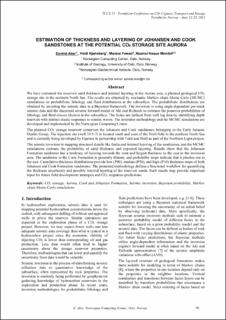| dc.contributor.author | Aker, Eyvind | |
| dc.contributor.author | Kjønsberg, Heidi | |
| dc.contributor.author | Fawad, Manzar | |
| dc.contributor.author | Mondol, Nazmul Haque | |
| dc.date.accessioned | 2021-09-21T14:05:03Z | |
| dc.date.available | 2021-09-21T14:05:03Z | |
| dc.date.issued | 2021 | |
| dc.identifier.isbn | 978-82-536-1714-5 | |
| dc.identifier.issn | 2387-4295 | |
| dc.identifier.uri | https://hdl.handle.net/11250/2779937 | |
| dc.description.abstract | We have estimated the reservoir sand thickness and internal layering in the Aurora area, a planned geological CO2 storage site in the northern North Sea. The results are obtained by stochastic Markov chain Monte Carlo (MCMC) simulations on probabilistic lithology and fluid distributions in the subsurface. The probabilistic distributions are obtained by inverting the seismic data in a Bayesian framework. The inversion is using angle-dependent pre-stack
seismic data and the linearized seismic forward model of Aki and Richards to estimate the posterior probabilities of lithology and fluid classes (facies) in the subsurface. The facies are defined from well log data by identifying depth intervals with distinct elastic responses to seismic waves. The inversion methodology and the MCMC simulations are developed and implemented by the Norwegian Computing Center.
The planned CO2 storage reservoir comprises the Johansen and Cook sandstones belonging to the Early Jurassic Dunlin Group. The injection site (well 31/5-7) is located south and west of the Troll field in the northern North Sea and is currently being developed by Equinor in partnership with Total and Shell as part of the Northern Light project. The seismic inversion is mapping structural details like faults and internal layering of the sandstones, and the MCMC simulations estimate the probability of sand thickness and expected layering. Results show that the Johansen Formation sandstone has a tendency of layering towards the west and largest thickness to the east in the inversion area. The sandstone in the Cook Formation is generally thinner, and probability maps indicate that it pinches out to the east. Cumulative thickness distributions provide low (P90), median (P50), and high (P10) thickness maps of both Johansen and Cook Formation sandstones. The presented methodology defines a functional workflow for quantifying the thickness uncertainty and possibly internal layering of the reservoir sands. Such results may provide important input for future field development strategies and CO2 migration predictions. | en_US |
| dc.language.iso | eng | en_US |
| dc.publisher | SINTEF Academic Press | en_US |
| dc.relation.ispartof | TCCS–11. CO2 Capture, Transport and Storage. Trondheim 22nd–23rd June 2021
Short Papers from the 11th International Trondheim CCS Conference | |
| dc.relation.ispartofseries | SINTEF Proceedings;7 | |
| dc.rights | CC BY 4.0 | * |
| dc.rights.uri | https://creativecommons.org/licenses/by/4.0/ | * |
| dc.subject | CO2 storage | en_US |
| dc.subject | Aurora | en_US |
| dc.subject | Cook and Johansen Formation | en_US |
| dc.subject | Seismic inversion | en_US |
| dc.subject | Bayesian probability | en_US |
| dc.subject | Markov chain Monte Carlo simulations | en_US |
| dc.title | Estimation of Thickness and Layering of Johansen and Cook Sandstones at the Potential Co2 Storage Site Aurora | en_US |
| dc.type | Chapter | en_US |
| dc.type | Peer reviewed | en_US |
| dc.type | Conference object | |
| dc.description.version | publishedVersion | en_US |
| dc.rights.holder | © 2021 The Authors. Published by SINTEF Academic Press. | en_US |
| dc.subject.nsi | VDP::Teknologi: 500 | en_US |
| dc.identifier.cristin | 1936800 | |
| dc.relation.project | Norges forskningsråd: 280472 | en_US |

